Urticaria in adults is not such a rare occurrence. The disease got its name from the external resemblance of the urticarial rash to a nettle burn.
Urticaria has always been considered a childhood disease, but an adult in everyday life encounters more allergens than a child.
According to statistics, every fifth adult on the planet found signs of nettle fever on their body.
Urticaria can occur as a reaction of the body to an external irritant, or as a result of chronic diseases of the endocrine system, gastrointestinal tract or blood pathology. According to experts, women suffer from urticaria more often than men.
Types of urticaria in adults
Depending on the causes of nettle rash, medicine distinguishes several forms of the disease in adults.
Forms of urticaria:
- Spicy. The first symptoms of the disease appear a couple of hours after contact with the allergen. The acute form may disappear on its own after stopping contact with the irritant. Nettle rash is accompanied by high fever, itching and general malaise.
- Acute form with Quincke's edema. Skin rashes are accompanied by swelling of the extremities and mucous membranes. Swelling of the neck and larynx is especially dangerous, as suffocation can occur. If discomfort occurs during swallowing, the patient needs emergency medical care. It is not recommended to self-prescribe injections for acute urticaria, as this may result in undesirable consequences.
- Relapsing chronic urticaria fever. This form is more difficult for patients to tolerate, leading them to nervous exhaustion with constant itching. The disease can last for years, remission is replaced by exacerbation at the slightest contact with an irritant.
- Chronic papular urticaria in adults. It is impossible to know in advance how long urticaria lasts; skin rashes can remain on the skin for several days or a month. Swelling and blisters are located in the bends of the limbs, eventually forming dense nodules.
Depending on what is the irritant, nettle fever comes in different types.
Types of urticaria:
- Allergic urticaria in adults. This is the most common type of urticaria, occurring on medications, food, and household chemicals.
- Solar urticaria. Photodermatosis most often affects women. After prolonged exposure to the sun, pink blisters appear on the skin, which then merge into one large spot.
- Heat or cold urticaria in adults. People suffering from temperature changes notice a nettle rash after taking a bath, taking a bath, or walking in the cold. How to treat this type of urticaria? Perhaps this is the easiest type of therapy - protect yourself from heat or cold, and the symptoms of urticaria will no longer appear.
- Contact urticaria. Blisters on the body appear after mechanical stress, for example, from wearing shoes and clothes that are smaller in size. As a rule, signs of urticaria in adults disappear after the irritant is eliminated.
What causes hives? Many dermatologists are inclined to believe that the body's increased sensitivity to allergens is inherited. The causes of nettle rash can be external and internal.
Causes of urticaria
External reasons:
- Constant stress;
- Professional activities related to petroleum products, acids and other chemicals;
- Taking certain antibiotics;
- Bites of various insects;
- Eating allergenic foods (chocolate, honey, citrus fruits);
- Constant contact with household chemicals;
- Pet fur;
- Weather conditions: frost and sun;
- Molds;
- Pollen of flowering plants and trees;
- House dust.
Internal reasons:
- Chronic diseases of the gastrointestinal tract;
- Malfunctions of the endocrine system;
- Kidney and liver diseases;
- Entry of pathogenic bacteria and viruses into the body;
- Various tumor processes.
Symptoms of urticaria in adults
Urticaria in adults can be distinguished by symptoms characteristic only of this disease.
Symptoms of urticaria:
- Itching appears. The skin itches, a burning sensation appears;
- At the site of scratching, the epidermis swells slightly and blisters appear;
- The shape of the formations that appear is oval or round;
- With a profuse rash, the formations merge into a large plaque;
- On the legs and arms, blisters may thicken and turn white;
- Often the symptom of a nettle rash is high fever and muscle weakness.
In the absence of swelling and profuse rashes, urticaria is not considered a serious disease. After the blisters completely disappear, the skin takes on a healthy appearance without any marks. But if, after completing a course of treatment for urticaria, the symptoms of the disease continue to bother the patient, it means that the disease has become chronic.
A dangerous symptom of urticaria in adults is angioedema. If blisters have spread throughout your body and breathing is difficult, you should call emergency services. Before her arrival, you need to complete the following steps.
First aid for swelling:
- Unbutton your outerwear;
- Take any antiallergic medicine;
- Ventilate the room;
- Apply nasal drips containing xylometazoline;
- If the skin rash is caused by an insect bite, apply a cold compress to the affected area.
Drug treatment
To completely cure urticaria, it is necessary to identify the cause of the skin rash.
Stages of treatment:
- Complete elimination of contact with the irritant;
- Cleansing the body of the presence of an allergen (gastric lavage, intestinal cleansing);
- Elimination of all allergenic foods from food;
- Normalization of the gastrointestinal tract (taking probiotics).
Doctors also recommend limiting contact with pets, doing wet cleaning at home more often, and avoiding prolonged exposure to sunlight.
Drug therapy:
- Antihistamines. Zodak, Claritin, Suprastin and other remedies will help cope with the first symptoms of urticaria in adults;
- Sedatives. Soothing tinctures or tablets will help get rid of insomnia caused by severe itching;
- If antihistamines are ineffective, the patient is prescribed glucocorticosteroids - Prednisolone or Dexamenazone;
- For chronic urticaria in adults, autohemotherapy - treatment with venous blood mixed with saline - has a positive effect. The procedure is carried out every six months.
- Removing toxins from the body with activated carbon, Enterosgel, Polysorb;
- Restoration of intestinal microflora: Laktovit, Hilak - Forte.
Many drugs cannot be used during pregnancy and childhood, so drug treatment should only be prescribed by a doctor. List of ointments against urticaria for adults and children.
Treatment with folk remedies
Traditional medicine recipes can complement drug treatment for nettle rash. How to quickly cure urticaria? Decoctions and tinctures made at home, proven over the years, will come to the rescue.
Traditional recipes:
- A decoction of medicinal plants. In equal proportions, chamomile, string, oak bark and nettle are poured with boiling water and infused for about an hour. The prepared decoction should be used to moisten blisters on the skin.
- Potato gruel. Grate raw potatoes and apply the resulting mass to the affected areas of the skin. This remedy perfectly relieves itching and swelling.
- Therapeutic bath. Dry herbs of celandine, St. John's wort, string and valerian are poured with boiling water and infused for 30 minutes. Strain the resulting broth and pour into the bath. Do water procedures daily before bed for 20 minutes.
- Mint tea. Brew mint leaves and leave for about an hour. Take the decoction three times a day before meals.
- Yarrow decoction. Brew one teaspoon of medicinal herb with boiling water. Drink the infusion three times a day until the symptoms of the nettle rash disappear.
Diet for urticaria
Complex therapy consists not only of medications taken, but also requires adherence to a special diet. It is necessary to exclude all allergenic foods from the diet.
Prohibited products:
- Eggs;
- Seafood;
- Chocolate;
- Honey;
- Sweets;
- Coffee;
- Alcohol;
- All fruits except apples and pears.
What you can eat:
- Lean meats (turkey, chicken breast, beef);
- Oatmeal and rice porridge;
- Boiled potato dishes;
- Fermented milk products with low fat content;
- Fresh vegetables: cabbage, zucchini, cucumbers.
If the dynamics of treatment are positive, allergenic foods should be introduced into the diet gradually. You can only eat one dish per day. You may have to forget about some of your favorite treats forever.
Features of urticaria and photos
Adults suffer more severely from the disease, and the likelihood of complications increases several times compared to children. With prolonged contact with the allergen, nettle fever becomes a chronic disease. Treatment methods generally depend on the complexity of the disease and the cause of its occurrence.
What does urticaria look like in adults?
After discovering blisters of unknown origin, many people are tormented by the question - what does hives look like? The main symptom of a nettle rash is flat pink blisters that rise slightly above the surface of the skin. Each type of urticaria has its own characteristics of the manifestation of the disease.
Consequences and prevention
Seemingly harmless flat formations on the skin can cause a number of serious complications.
Consequences of nettle fever:
- Quincke's edema;
- Anaphylactic shock;
- Penetration of bacteria into the body when scratching the upper layer of the epidermis.
It is quite possible to avoid nettle fever if you pay close attention to your health.
Prevention of urticaria:
- Avoid contact with the allergen (if identified);
- Strengthen the immune system;
- Get rid of bad habits;
- Eliminate chronic gastrointestinal diseases;
- Review your daily diet and, if possible, exclude allergenic foods from it.
With the right treatment, following a diet and all the recommendations of the attending physician, you can get rid of hives within 2-3 days.
Treatment of urticaria in adults - video
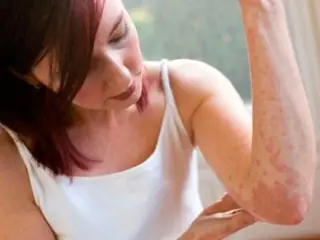
Urticaria is a fairly common pathology, characterized by the appearance of pinkish or reddish, very itchy blisters on the dermis, rising above the surface of the dermis.
Urticaria in an adult is dangerous, as it is much more severe than in a child and, if treated untimely or inappropriately, can cause disastrous consequences. In the photo you can see what the disease looks like.
Externally, the skin rash is similar to a nettle burn. The main cause of the disease is allergies. However, the occurrence of urticarial rash can also be caused by the presence of oncological pathologies, central nervous system disorders and disruptions in the functioning of the gastrointestinal tract. The disease can develop due to wearing uncomfortable tight clothing. Urticaria is often diagnosed in pregnant women as one of the manifestations of toxicosis.
Only a qualified specialist can identify the exact cause and establish a diagnosis and only after an examination. The appearance of rashes is associated with increased vascular permeability and the development of edema.
The development of pathology is usually determined by:
- genetic predisposition;
- the presence of neoplasms;
- the body's reaction to an organ transplant or blood transfusion;
- intolerance to medications;
- food allergies;
- insect bites;
- exposure to physical factors (ultraviolet radiation, low or, conversely, high temperatures, touch of metal);
- helminthic infestations;
- hormonal imbalance;
- stressful situations;
- allergies to household chemicals;
- hypersensitivity to pollen, dust, pet fur;
- autoimmune response (identification of body cells by the immune system as foreign, followed by their damage);
- the presence of diabetes, arthritis, thyroiditis;
- diseases of bacterial and viral nature.
Many people ask the question: “Why is urticaria dangerous in adults?” If treatment measures are taken in a timely manner, the disease does not pose any danger to the body. However, ignoring the manifestations of the disease is fraught with anaphylactic shock, accompanied by swelling of the larynx, which often causes death. There are acute, chronic recurrent and papular persistent, as well as spontaneous urticaria. The last group is divided into many varieties associated with the body's immediate reaction to the allergen.
For example, the appearance of solar urticaria is caused by exposure to infrared and ultraviolet radiation on the dermis. The development of heat is provoked by local heat stroke. Cold allergy is the body's response to low temperatures. The appearance of vibration (a rare variety) is provoked by contact with devices that generate vibration. Demographic urticaria occurs due to damage to the upper layers of the skin (even minor ones). The appearance of delayed urticaria is caused by squeezing or pressing the dermis over a long period of time.
Aquagenic allergy develops after water droplets come into contact with the dermis on which the allergen was present. The development of contact urticaria is provoked by contact of the dermis with an allergen: animal hair, pollen. The occurrence of cholinergic is caused by strong emotional or mental stress. Adrenergic may develop due to sudden joy or fear. The acute form of the pathology develops instantly. The duration of the illness ranges from several hours to several days.
A characteristic feature of acute urticaria is the complete disappearance of symptoms. After eliminating the action of the irritant, not a trace remains on the dermis. As for the chronic form, it appears against the background of developing infectious processes: tonsillitis, caries, adnexitis, as well as minor disruptions in the functioning of the gastrointestinal tract and liver. In order to prevent the development of complications, it is necessary to start treatment on time - when the first symptoms of the pathology appear. The first sign of hives is intense itching.
In addition to this symptom, the disease is characterized by:
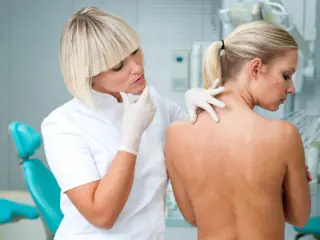
the appearance of pink or red blisters on the dermis, flat and with unclear boundaries, they can have different sizes and be localized in different parts of the body;- malaise;
- increase in temperature;
- chills;
- stool disorder;
- nausea;
- spastic pain;
- itching, hyperemia and swelling of the skin.
The main manifestation of the papular form of the disease is persistent tissue swelling. In addition, the disease is accompanied by hyperpigmentation of the dermis in the area of folds and thickening of the stratum corneum of the epidermis. You can ask your doctor directly about the dangers of urticaria in adults. This disease, if its symptoms are ignored or assistance is not provided in a timely manner, is fraught with unpredictable and even critical consequences.
If signs such as severe nausea, progressive swelling of the neck and face, a feeling of lack of oxygen, pre-fainting or fainting state appear, it is necessary to immediately call an ambulance and provide the patient with emergency assistance, which consists of intramuscular injection of drugs with anti-allergic effects: Tavegil, Suprastin .
Scratching the elements is fraught with the addition of a secondary infection, as well as the appearance of pyoderma and furunculosis. The most dangerous complication of urticaria, which poses a threat to human life, is angioedema, in which, due to narrowing of the airways, air does not enter the lungs in the required quantity. The result is the development of asphyxia. Urticaria in adults is dangerous, as if left untreated it can lead to disastrous consequences.
Treatment of pathology must be correct and timely. Only a qualified specialist can carry out treatment and prescribe medications. Treatment of the disease consists of the use of antihistamines, ointments and creams, adherence to a hypoallergenic diet, as well as the use of traditional medicine. Prevention plays an important role in preventing the development of the disease or its exacerbation.
Why urticaria is dangerous and how to treat it using traditional and alternative medicine
Pathology therapy must be comprehensive. Etiotropic treatment consists of eliminating contact with the allergen, as well as eliminating it from the diet. If the occurrence of urticarial rash and other manifestations is provoked by taking medications, their use is prohibited for life.
In addition, it is necessary to carefully treat surfaces from dust, as well as limit or completely eliminate contact with pet hair, pollen and other allergens. Urticaria is a dangerous disease. If the disease develops during pregnancy against the background of toxicosis (no matter at what stage, early or later), it can pose a danger not only to the woman who is carrying the fetus, but also to the child.
If not treated promptly, urticaria can cause suffocation. In addition, pregnant women are not allowed to take all medications. Most medications can have a toxic effect on the fetus. As a result of inappropriate medication use, children may be born with pathologies and anomalies. Therefore, if a pregnant woman develops the disease, before taking any drug, it is necessary to consult a doctor regarding its appropriateness. Every person should know the dangers of urticaria and be able to provide emergency care.
Drug treatment
Systemic treatment of pathology involves the use of medications. Often prescribed:
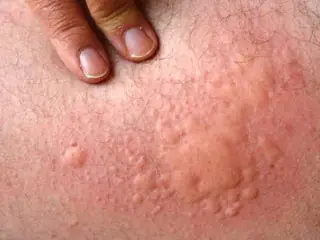
taking antihistamines: Loratadine, Chloropyramine, Fexofenadine, Desloratadine, Zodac, Zyrtec;- use of glucocorticosteroids: Prednisolone, Dexamethasone (in the case of generalized urticaria);
- intravenous infusion of sodium thiosulfate;
- administration of a solution of adrenaline (for acute swelling of the larynx and difficulty breathing).
Local therapy consists of the use of ointments, creams and gels: Fenistil, Soventol, Psilo-balm, Cloveit, Advantan, Flucinar. In order to minimize itching, it is recommended to wipe the areas affected by the rash with a vodka solution, a solution of vinegar, diphenhydramine, and use a hot shower. It is also recommended to carry out a course of hepatoprotective therapy, taking enzymes and choleretic drugs. In order to restore the intestinal microflora, the use of Colibacterin and Bifidumbacterin is prescribed.
Traditional methods
A good therapeutic effect can be achieved by using alternative medicine in the fight against the disease. Compositions from medicinal plants will help minimize the manifestations of urticaria, improve general condition and well-being, and strengthen the immune system.
However, it is preferable to use them after prior consultation with your doctor. You should not self-medicate, this can lead to disastrous consequences.
- Healing infusions will help in treating the disease. You need to brew 30 grams of dried chamomile in half a liter of boiling water. The product should be infused for an hour. It is recommended to use filtered liquid for wiping the affected areas of the skin. In a similar way, infusions of string, nettle and burdock rhizomes are prepared.
- Treatment of urticaria with celery juice. This remedy helps to increase the body's protective properties and treat urticaria. You need to take fresh rhizomes of the plant, chop them, and then squeeze out the juice. It is recommended to use 10 ml of the drug four times a day.
- Clarity in the fight against pathology. You need to take the dried flowers of the plant and steam 20 grams in 200 ml of just boiled water. After an hour you can take the composition. It is recommended to drink a quarter glass of strained drink three times a day.
- Yarrow against allergies. It is necessary to brew 15 grams of finely chopped dry plant in 300 ml of boiling water. The composition must be infused in a warm place for two hours. It is recommended to consume 60 ml of filtered medicine four times a day.
- The use of healing tinctures. Doctors advise taking thirty drops of mixed tinctures (valerian, motherwort and hawthorn) before bed.
- Treatment of illness with herbal tea. You need to combine lemon balm with valerian and hop cones in equal proportions. Next, the raw material is filled with boiled water and left in a warm place for two hours. You need to drink a third of a glass of the strained mixture three times a day.
To prevent the occurrence of pathology or exacerbation of the chronic form, it is necessary not only to avoid contact with a possible allergen, but also to eat properly. People suffering from the pathology are advised to give up all foods that can provoke the appearance of symptoms: citrus fruits, strawberries, seafood, raspberries, blackberries, chocolate, watermelons, radishes, mushroom, meat and fish broths, melon, sausage, mayonnaise, spices, fatty , fried and spicy dishes, marinades.
It is recommended to introduce boiled potatoes, cereals, seasonal vegetables (steamed or stewed), and fermented milk products into the diet. In addition, you need to drink more liquid (purified still water). Every person should know why urticaria is dangerous and how it manifests itself.
To prevent the development of pathology or its exacerbation, it is recommended:
- exclude contact with the irritant;
- follow a hypoallergenic diet;
- strengthen the immune system;
- give up bad habits;
- undergo supportive desensitization treatment;
- stop using household chemicals;
- wear comfortable clothes;
- avoid hypothermia;
- do not abuse medications.
When acute urticaria is diagnosed, the prognosis is favorable. In most cases, the pathology is completely cured and, if the doctor’s recommendations are followed, exacerbations do not occur. As for the chronic form, if the cause of the disease is not identified and if appropriate therapy is not prescribed, it can last for years.
According to medical statistics, from 20 to 30% of the population of our planet have suffered from urticaria at least once in their lives. And those who have never suffered this illness themselves, to one degree or another, have at least a general idea of it. The idea that this is a childhood disease is absolutely wrong. Urticaria (Urticaria), a skin disease (mainly of an allergic nature), can occur in people of all ages. In our review article we will try to tell you what causes urticaria in adults, how to treat it, and also talk about publicly available preventive measures that will help prevent this disease.
External signs of the disease
What does urticaria look like in adults? The main external signs of the disease are the appearance on the body of numerous severely itchy redness, induration, inflammation, spots and blisters (fairly flat) of red or pink color. In appearance, the swelling is largely reminiscent of nettle burns (hence the common name). The development of the disease can occur very quickly: neoplasms on the body can appear within just a few minutes. The size of the swelling varies from a few millimeters to tens of centimeters. Over time, several small blisters may merge into one. External symptoms of urticaria appear on the legs, arms, back, abdomen and other parts of the body. It is especially dangerous for human health when swelling affects the respiratory tract (the person begins to choke) and the genitals (which leads to the inability to urinate).

Minor signs
Associated symptoms of urticaria in adults include the sudden onset of muscle weakness, headache, nausea, chills, runny nose, diarrhea, fever, fever and cough. These secondary signs sometimes make it difficult to make a correct diagnosis, especially if the inflammation of the skin is not too obvious. It is easy to confuse the disease with, for example, ordinary food poisoning.
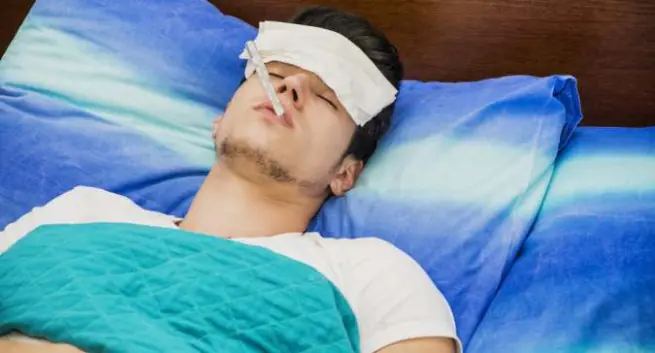
The mechanism of occurrence and development of urticaria
What causes urticaria in adults? The composition of human skin (and other connective tissues) includes mast cells that have capsules inside filled with histamine. When an allergic reaction occurs in the human body, this substance is released, enters the subcutaneous space through capillary vessels, accumulates and causes swelling and rash. That is, the mechanism of the disease is the rapid release of histamine from mast cells.
If the swelling can be stopped within 36 hours, then no damaged areas remain on the skin. Otherwise, damage to the walls of blood vessels begins.
Important! If, during the course of the disease, swelling spreads to the respiratory system, this can lead to the most severe consequences. In this case, emergency medical care is required!
Varieties
There are two main types of urticaria:
- Spicy. The duration of the disease usually does not exceed 5-6 weeks. As a rule, with proper and timely treatment, external manifestations can be eliminated within 24-36 hours.
- Chronic. Symptoms may last for several months (in particularly severe cases, even several years). According to experts, about 0.1% of humanity currently suffers from this disease.
Please note: one of the most dangerous types of acute urticaria is angioedema. It is accompanied by the rapid formation of compactions in the area of the eyes, lips and cheeks. The main danger is possible swelling of the larynx, which can lead to asphyxia (with all the ensuing consequences). To prevent death, urgent drug treatment is required.
Causes of allergic urticaria
The main cause of urticaria in adults is the body's reaction to a specific allergen. Moreover, a person may not even know what substance was the “provocateur” of the disease. The main triggers that cause a true allergic reaction in the body are food, medications, chemical compounds (including household detergents), pet hair, insect bites (bees, wasps, ticks, flies or cockroaches), pollen and, oddly enough, even ordinary household dust. In some cases (even with comprehensive examinations and numerous laboratory tests), the true cause of the disease cannot be determined.
One of the reasons for the appearance of urticaria in adults, no matter how paradoxical it may sound, is age. With its increase (especially after 40 years), the allergic reactions of the human body intensify. And, as a result, Urticaria can become a reaction to any everyday food product or habitual medicine.
On a note! If you find obvious signs of urticaria in an adult after sleep, then most likely the cause could be bites of the so-called bed tick. In addition to treating the disease itself, it is necessary to properly treat all bedding (mattress, pillows, blanket, etc.).
Non-allergic causes of the disease
In addition to allergies, the causes of urticaria in adults can be:
- various (especially chronic) diseases of the liver, kidneys, gastrointestinal tract, endocrine system, thyroid gland;
- pathogenic bacteria and viruses;
- inflammatory processes;
- stressful situations;
- intestinal parasites;
- the body's reaction to a sharp drop in ambient temperature or solar activity.
Diagnostics
An experienced specialist, when examining a patient and visually examining the skin rash, can find out what causes urticaria in adults. To make a correct diagnosis, a doctor (dermatologist, allergist or immunologist), first of all, will need detailed answers from the patient to the questions posed to him:
- When did external signs begin to appear?
- Was there an insect bite before this and, if so, what kind?
- What medications (and in what dosages) was the person taking before the incident?
- What did the patient eat during the day?
- What chronic diseases does the patient suffer from?
- Was there any contact with animals or chemicals?
As a rule, detailed answers to the above questions will be enough for an experienced specialist to make the correct diagnosis and prescribe effective treatment. The main thing is to find out the reason that caused the hives, because the next encounter with this allergen can lead to more serious consequences.
For chronic urticaria, laboratory tests are prescribed:
- general and biochemical blood test;
- test to identify problems with the immune system;
- skin tests;
- determination of the content of immunoglobulin E (its increased concentration indicates a predisposition to allergic reactions of the body, including urticaria);
- stool analysis to identify the presence of parasites in the body;
- checking the functioning of the kidneys, liver, thyroid gland and gastrointestinal tract.
Since sometimes even numerous laboratory tests do not allow us to identify the true cause of urticaria, in case of a chronic recurrent disease, a journal with records of all the events preceding the incident will help to identify the trigger. Subsequent analysis of systematized data greatly simplifies the search for a “provocateur.”
Drug treatment of acute urticaria
Various antihistamines have been successfully used to treat acute urticaria. Most of these medications are available without a prescription. And although experts do not recommend self-medication with medications, success in the fight against the disease largely depends on efficiency (often running to the pharmacy for medicine will take much less time than waiting for the local doctor to arrive).
The list of the most popular and very effective drugs taken for urticaria in adults: Diazolin, Cetrin (Cetirizine), Zyrtec, Fexofenadine, Erius. These medications help block the negative effects of histamine, reduce external rashes, and stop painful itching. In most cases, after the surgical use of these medications, a positive effect is observed. But further actions related to how and how to treat urticaria in adults should be done only after consultation with a specialist. It is he who will determine the duration of the course of treatment and give all the necessary recommendations.
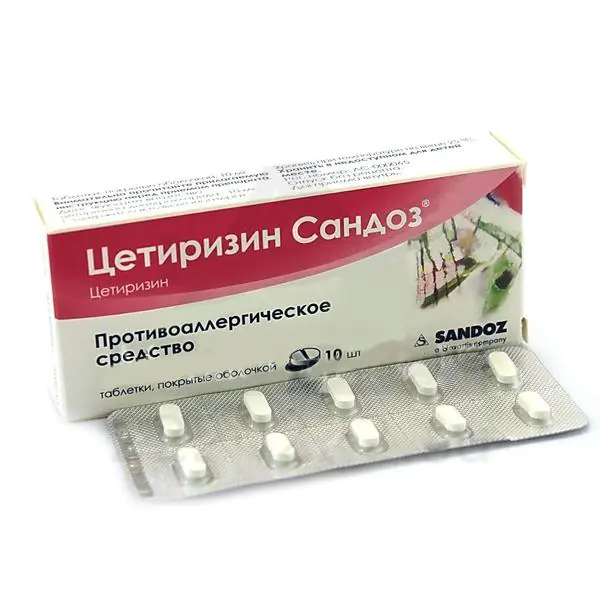
Treatment of chronic urticaria
When treating chronic urticaria, antihistamines (even in fairly large doses) cannot quickly reduce swelling and itching. How to treat urticaria in adults in this case? Specialists use special hormonal drugs – glucocorticosteroids – to treat chronic urticaria. The most well-known and frequently used medications of this group, produced in the form of tablets or injections: Prednisolone, Dexamethasone, Prednisone, Triamcinolone, Betamethasone.
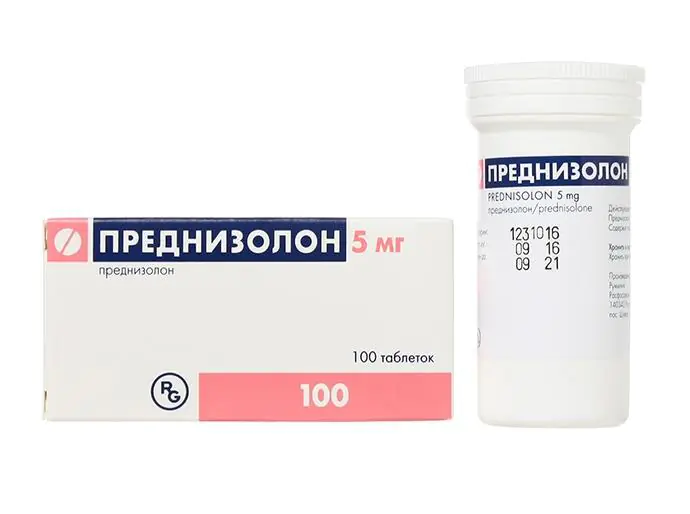
Using hormones on a regular basis is difficult because of the risk of serious side effects such as osteoporosis, glaucoma, diabetes, and a weakened immune system in general. Therefore, so-called monoclonal antibodies have recently been successfully used to treat severe cases of frequently recurring urticaria. The injectable drug "Omalizumab" ("Omalizumab" or "Xolair") blocks molecules of the immunoglobulin E protein, which plays a major role in the body's allergic reactions. A positive effect is observed even in the treatment of urticaria of unknown origin. A course of use of this drug leads not only to the elimination of symptoms, but also removes the causes of the chronic disease until it is completely cured.
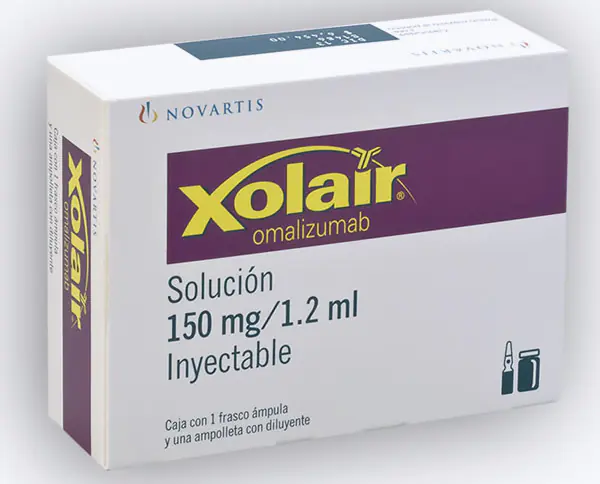
First aid for urticaria in adults
Before being examined by a doctor and prescribing treatment methods, the patient can provide first aid to himself at home:
- First of all, we ventilate the room;
- we take any antiallergic drug (if it is available in the home medicine cabinet);
- take off clothes or put on looser clothes (made of soft materials that do not injure the skin);
- take a cool shower or bath;
- apply cold compresses to the most itchy areas;
- We go to bed (under no circumstances should you tolerate hives on your legs).
When is emergency medical care required?
Severe cases of allergic urticaria require immediate medical attention. The main signs for calling emergency help are:
- swelling of the lining of the mouth, tongue, lips, and throat;
- labored breathing;
- high body temperature (39°C or more);
- loss of consciousness or inadequacy in expressing thoughts;
- cardiopalmus;
- severe nausea and vomiting;
- cold and clammy skin.
If a patient with the symptoms described above is not provided with emergency medical care, this can lead to very serious consequences, even fatal.
Diet
Strict adherence to a certain diet plays an important role in the treatment of urticaria. First of all, foods that have the greatest effect on the production of histamine in the body’s mast cells should be excluded from the diet. These include spinach, chocolate, strawberries, fatty meats, tomatoes, yoghurts, fish and other seafood (shrimp, crabs, etc.). Also, during the treatment period, you should not drink alcoholic beverages, honey (and other sweets), eggs, coffee and strong tea.

What you can eat if you have hives: porridge (oatmeal or rice), boiled potatoes, fresh vegetables (cabbage, zucchini or cucumbers), boiled lean meat (turkey, chicken breast or beef), pears and apples.
Folk remedies in the fight against urticaria
The treatment of urticaria with folk remedies in adults must be approached with extreme caution. Any ingredient (or maybe several at once) may be a trigger for an allergic reaction, which the patient may not even be aware of, since he has not encountered it in everyday life. Before putting into practice the recipes of traditional healers, it is better to first consult with a specialist.
How to relieve itching with urticaria in an adult:
- Pour boiling water over a mixture of equal parts of string, chamomile and oak bark. Let it brew for 1-1.5 hours. Strain the broth and gently moisten the blisters with it.
- A paste of grated raw potatoes applied to inflamed areas helps to significantly reduce itching and swelling.
- A bath with the addition of an infusion of valerian leaves, celandine, St. John's wort and string to the water helps reduce pain symptoms.
Two simple and affordable recipes for treating urticaria in adults with folk remedies:
- Pour boiling water over mint leaves and leave for 30-40 minutes. Take orally three times a day before meals.
- Tea from walnut leaves, prepared at the rate of 2 teaspoons per 0.5 liter of water. A special feature of the preparation is the brewing time - at least 10 minutes.
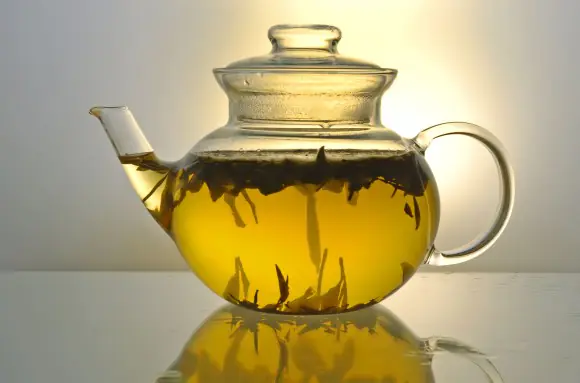
Preventive measures
We briefly addressed the question of what causes urticaria in adults and how to treat it. However, taking fairly simple preventive measures will help significantly reduce the risk of this disease:
First of all, it is necessary to completely eliminate contact with specific allergens known to a person from personal experience or identified during clinical studies.
Getting rid of bad habits (for example, drinking alcohol and smoking) will not only have a positive effect on overall physical health, but will also strengthen the body's anti-allergic capabilities. Timely treatment of pathologies of the gastrointestinal tract, liver and kidneys will help reduce the likelihood of urticaria.
Both overheating and hypothermia of the body should be avoided. Therefore, sunbathing and walking in the cold need to be dosed wisely. Emotional stress not only weakens the nervous system, but can also be a trigger for the occurrence of hives. Therefore, naturally, if possible, they should be avoided or at least minimized.
Last (but not least) what you should pay attention to is your daily diet. Excluding highly allergenic foods from it significantly reduces the likelihood of developing the disease.



